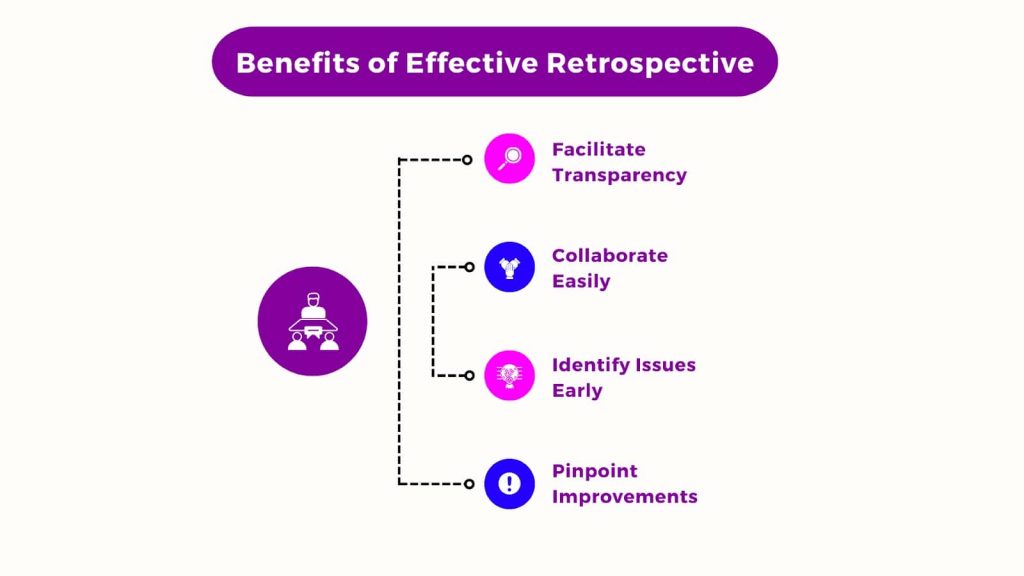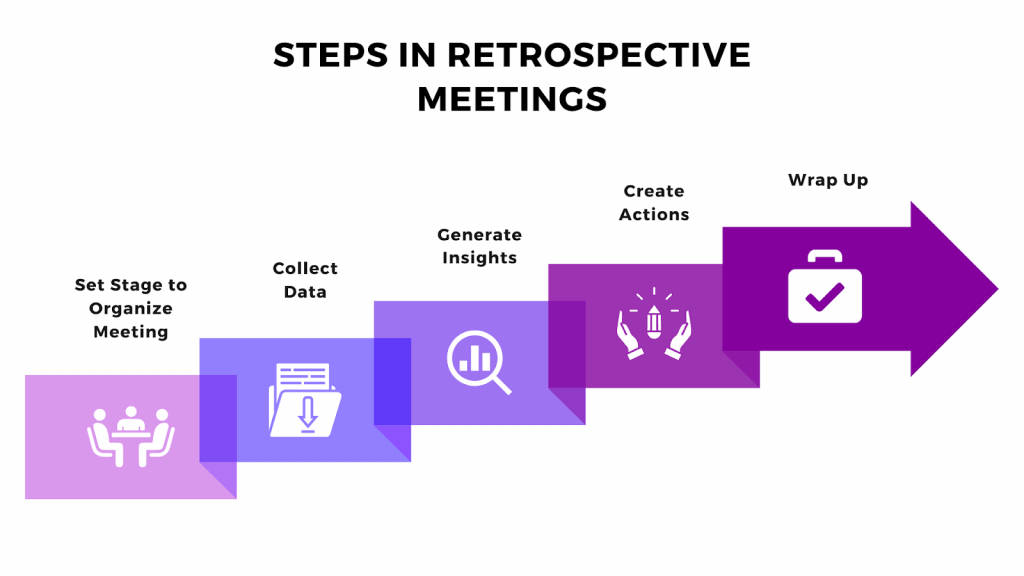
What is a Retrospective?
A retrospective sometimes called an agile retrospective, is a meeting after the product is shipped.
Agile teams use it to reflect on their way of working throughout the product life cycle and ponder the ideas. That is about how they could do better in the following product cycle.
In this meeting, the teams analyze how they achieved the previous iteration. And what process they could adapt to improve their performance for the next iteration.
The retrospective outcomes get communicated to all the team members. Everyone gets asked to include these ideas in the following product iteration.
This makes the retrospectives an effective way to make short cycled improvements.

As the old saying goes, “To err is human,” no product team is immune to making mistakes.
A retrospective is an excellent place to inspect everything, whether it’s some minor oversights, misunderstandings, or a product failure.
When a similar situation arises in the future, a person is prepared to handle it properly.
It’s not just you who is affected. Sometimes the whole project could get sabotaged due to a tiny error.
The value of the meeting comes from conversations and dialogues. The format of the meeting plays a vital role in this.
Ideally, there must be a representative for each group present. The representative should get adequate floor time to share their team’s view on the product and product management software.
Doing this would give every team member a chance to share their input on the product, ultimately benefiting upcoming releases.
The participants are encouraged to bring up any positives or negatives about the product that catches their attention.
The retrospective is a safe space for bringing up contentious issues and contrary views to be as efficient and insightful as possible.
Product managers mostly lead these meetings as they have the most cross-functional role in the organization. And better understand what happened during product development and decide how effectively they are using product development tools.
However, it is also beneficial to include an impartial third-party facilitator. Their job is to ensure that everyone is treated equally and given adequate floor time.
When should a Retrospective be held?
Ideally, a retrospective should follow any major release or project within a week of shipping.
You can be more granular with it and hold micro-retrospectives.
These micro-retrospectives can be about just a topic or two.
But addressing something that went well or didn’t go well in a collaborative environment is a great way to learn from the success. Or even failures and build upon them moving forward.
Participants are likely to provide honest feedback and be receptive to the ideas of other members if they conduct these retrospectives more frequently.
If they only happen after something terrible happens, they’ll be associated with negativity, which isn’t the intent.
What should be the agenda of the retrospective meeting?
5 minutes to set things up:
The importance of first impressions cannot get overstated.
The first few minutes of your meeting are ideal for laying the groundwork for a successful retrospective by following these three steps:
- Appreciate your coworkers.
- Make an on-ramp available.
- Set the scene and define the parameters.
Data collection (10 minutes):
This is where your retrospective agenda’s creative phase begins. However, this does not imply that it is free-form.
On a shared screen or whiteboard, the team should collect particular types of ideas and observations on their work, along the lines of:
- What do we excel at?
- What are the things that we aren’t performing well?
- What have we discovered?
- What went wrong?
5-minute brainstorming session:
Now that you’ve identified some significant issues, it’s time to go to the root of the problem. Only by addressing issues at their core can they get genuinely solved.
Find them, and then change the what into the why:
- Why are we succeeding at x?
- Why aren’t we performing well at y?
- Why was it possible for us to learn from x?
- Why did you come up short with y?
Choose a solution (5 minutes):
After brainstorming, you may find yourself with an entire board: a few significant issues here, a slew of potential solutions there.
You won’t be able to apply all of them. Giving your team a few stars to follow rather than a never-ending Wishlist of tasks will make solutions easier to implement.
So, out of all the possibilities, which one should you choose?
Collaborate with your team and hold a vote. Maintain entries anonymous if you’re concerned about votes being too personal.
It may require a few minutes longer to gather and summarize them later. Still, if it aids in maintaining a safe environment, your retrospective is on the path.
How to run a retrospective meeting remotely?
Create a psychologically comfortable environment:
The entire team must participate in a retrospective for it to be worthwhile. This is important because it communicates that everyone is welcome, everyone belongs here, and everyone’s voice deserves acknowledgment.
Ensure that everybody feels free to express their true feelings without fear of judgment or reprimand.
Plan the schedule and logistics:
Retrospectives depend on common ownership and connectivity among team members, which sometimes gets lost in a dispersed workplace.
Use Zoom or a similar video conferencing application to resolve this problem and make sure everyone is visible. We interact more easily when we can see each other’s faces.
Because retrospective talks can get heated at times, you’ll want all the effective communication.
Address the various topics openly yet courteously:
The most exciting element of any retrospective is the dialogue.
While it’s preferable to leave it open-ended, providing “just enough” structure prevents you from wandering off tangents. Or delving too deeply into the details.
Decide on what you’ll do before the next retrospective:
What have you discovered? What are you going to change?
Specify owners and deadlines for each job or action item after deciding as a group. It’s not easy to track who’s doing what in a distributed team. Thus, it’s critical to develop (pleasant) ways to hold each other responsible.
Address the various topics openly yet courteously:
The most exciting element of any retrospective is the dialogue. While it’s preferable to leave it open-ended, providing “just enough” structure prevents you from wandering off on tangents or delving too deeply into the details.
Reflect on your retrospective:
Please take a moment after the retro to reflect on how it went. Allow for and encourage team comments, and find ways to improve the retrospective the next time around.

Questions to ask in a retrospective meeting:
- Is there anything else you can tell us?
- How did we manage to do it?
- What about it thrills you?
- Can we make that happen?
- What are the things that we are willing to change?
- What is preventing us from doing so?
- Is there a way to make that more effective?
- Is there a way we could do it better?
- Could we go about it differently?
- What’s to stop you?
- What’s keeping us from doing so?
- Are there other alternatives?
- What is so complicated about that?
- What is it about this that continues to confuse us?
FAQs
A retrospective does not have any right or wrong outcomes. There could, however, be some list of things that went well, something that went wrong, and things that could use a bit of improvement.
The product owner may choose to participate in the retrospective, being a part of the Scrum team, but is not required to be there.
